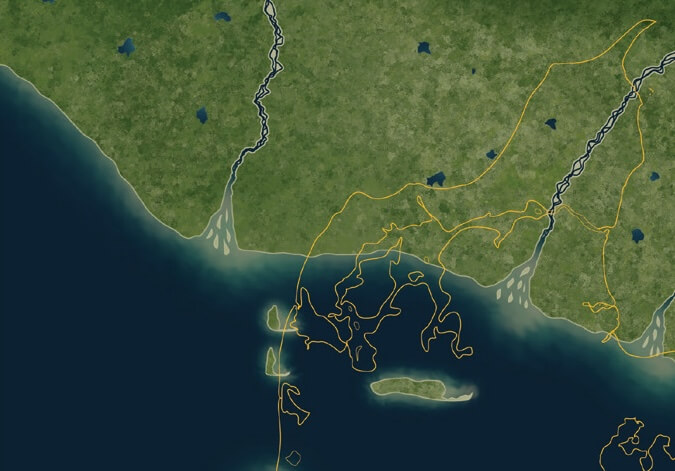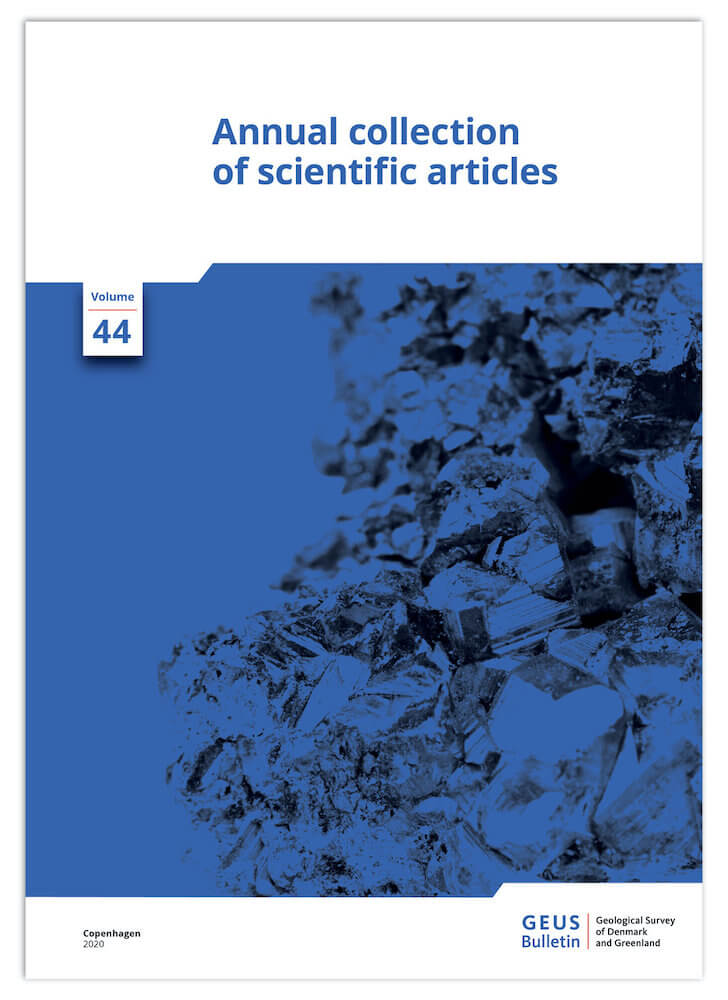
How to Cite
Share
Abstract
The early Miocene was an important period for the development of the eastern North Sea. Tectonism in North-West Europe resulted in uplift of the Scandinavian mountains, reactivation of salt structures, inversion of old graben structures and deposition of the most coarse-grained deposits in the Danish pre-Quaternary succession. Some of these deposits were later cemented into conglomerates. The deposits are common in the fluvial parts of the Billund Formation (Aquitanian) and the basal transgressive lag of the late Aquitanian – Burdigalian Klintinghoved Formation capping the Billund Formation. Questions remained as to the age of these deposits and what they infer about tectonic events in the region. This study reviews the geology of the flint-dominated conglomerates and presents the first dates for a sample of these unique deposits. We observe grain sizes up to 5 cm diameter. Palynological analyses place the sample as early Miocene. Some samples from the area have suggested a local source near active salt structures, associated with the uplift of the pre-Neogene sedimentary successions. We suggest that the common occurrences of flint clasts in the lower Miocene succession reveal significant erosion of Upper Cretaceous and Danian chalk, likely associated with the uplift of the Scandinavian lowlands during the Savian tectonic phase, early Miocene.
How to Cite
Share
Copyright (c) 2020 Erik Skovbjerg Rasmussen, Karen Dybkjær

This work is licensed under a Creative Commons Attribution 4.0 International License.
Downloads
References
-
Andsbjerg, J. et al. 2001: Divergent development of two neighbouring basins following the Jurassic North Sea doming event: the Danish Central Graben and the Norwegian–Danish Basin. In: Martinsen, O.J. & Dreyer, T. (eds): Sedimentary environments offshore Norway – Palaeozoic to recent. Norwegian Petroleum Society Special Publications 10, 175–197. https://doi.org/10.1016/s0928-8937(01)80013-8" target="_base">https://doi.org/10.1016/s0928-8937(01)80013-8
-
Andsbjerg. J. & Dybkjær, K. 2003: Sequence stratigraphy of the Jurassic of the Danish Central Graben. In: Ineson, J.R. & Surlyk, F. (eds): The Jurassic of Denmark and Greenland. Geological Survey of Denmark and Greenland Bulletin 1, 265–300. https://doi.org/10.34194/geusb.v1.4675" target="_base">https://doi.org/10.34194/geusb.v1.4675
-
Dybkjær, K. & Piasecki, S. 2010: Neogene dinocyst zonation in the eastern North Sea Basin, Denmark. Review of Palaeobotany and Palynology 161, 1–29. https://doi.org/10.1016/j.revpalbo.2010.02.005" target="_base">https://doi.org/10.1016/j.revpalbo.2010.02.005
-
Dybkjær, K. & Rasmussen, E.S. 2000: Palynological dating of the Vejle Fjord Formation (Chattian) and the lower part of the Arnum Formation (Aquitanian – lower Burdigalian), Lillebælt, Denmark. Bulletin of the Geological Society of Denmark 47, 87–103.
-
Dybkjær, K. & Rasmussen, E.S. 2007: Organic-walled dinoflagellate cyst stratigraphy in an expanded Oligocene–Miocene boundary section in the eastern North Sea Basin (Frida-1 Well, Denmark) and correlation from basinal to marginal areas. Journal of Micropalaeontology 26, 1–17. https://doi.org/10.1144/jm.26.1.1" target="_base">https://doi.org/10.1144/jm.26.1.1
-
Erlström, M. 1994: Evolution of cretaceous sedimentation in scania. Lund Publication in Geology 122, 1–37.
-
Green, P.F., Duddy, I.R. & Japsen, P. 2017: Multiple episodes of regional exhumation and inversion identified in the UK Southern North Sea based on integration of palaeothermal and palaeoburial indicators. Geological Society, London, Petroleum Geology Conference Series 8, 47–65. https://doi.org/10.1144/pgc8.21" target="_base">https://doi.org/10.1144/pgc8.21
-
Heilmann-Oausen, C., Nielsen, O.B. & Gersner, P. 1985: Lithostratigraphy and depositional environments in the Upper Paleocene and Eocene of Denmark. Bulletin of the geological Society of Denmark 33, 287–323.
-
Japsen, P. et al. 2007: Mesozoic–Cenozoic exhumation events in the eastern North Sea Basin: a multi-disciplinary study based on palaeothermal, palaeoburial, stratigraphic and seismic data. Basin Research 19, 451–490. https://doi.org/10.1111/j.1365-2117.2007.00329.x" target="_base">https://doi.org/10.1111/j.1365-2117.2007.00329.x
-
Jarsve, E.M. et al. 2014: Mesozoic and Cenozoic basin configuration in the North Sea. In: Martinus, A.W., et al. (eds): From depositional systems to sedimentary successions on the Norwegian Continental Margin, 417–452. International Association of Sedimentologists. https://doi.org/10.1002/9781118920435.ch15" target="_base">https://doi.org/10.1002/9781118920435.ch15
-
Knox, R. et al. 2010: Cenozoic. In: Doornenbal, J.C. & Stevenson, A.G. (eds): Petroleum Geological Atlas of the Southern Permian Basin Area, pp. 210–323. Houten: EAGE Publications b.v.
-
Koch, B.E. 1989: Geology of the Søby-Fasterholt area. Danmarks Geologiske Undersøgelse Series A 22, 171.
-
Larsson, L.M. et al. 2011: Miocene climate evolution of northern Europe: a palynological investigation from Denmark. Palaegeography, Palaeoclimatology, Palaeoecology 309, 161–175. https://doi.org/10.1016/j.palaeo.2011.05.003" target="_base">https://doi.org/10.1016/j.palaeo.2011.05.003
-
Nielsen, O.B., Rasmussen, E.S. & Thyberg, B. 2015: Distribution of clay minerals in the northern North Sea basin during the Paleogene and Neogene: a result of source-area geology and sorting processes. Journal of Sedimentary Research 85, 562–581. https://doi.org/10.2110/jsr.2015.40" target="_base">https://doi.org/10.2110/jsr.2015.40
-
Ødum, H. 1968: Flintkonglomeratet i Jylland. Tertiærformation og ledeblok. Meddelelser Dansk Geologisk Forening (Bulletin) 18, 1–24, +9 appendices, 4 plates.
-
Olivarius, M. et al. 2014: Provenance signal variations caused by facies and tectonics: zircon age and heavy mineral evidence from the Miocene sand in the north-eastern North Sea Basin. Marine and Petroleum Geology 49, 1–14. https://doi.org/10.1016/j.marpetgeo.2013.09.010" target="_base">https://doi.org/10.1016/j.marpetgeo.2013.09.010
-
Pharaoh, T. et al. 2010: Tectonic evolution. In: Doornenbal, J. C. & Stevenson. A. G (Eds.) Petroleum Geological Atlas of the Southern Permian Basin Area, 25–57. Houten: EAGE Publications b.v.
-
Rasmussen, E.S. 2004: The interplay between true eustatic sea-level changes, tectonics, and climatical changes: what is the dominating factor in sequence formation of the Upper Oligocene–Miocene succession in the eastern North Sea Basin, Denmark? Global and Planetary Change 41, 15–30. https://doi.org/10.1016/j.gloplacha.2003.08.004" target="_base">https://doi.org/10.1016/j.gloplacha.2003.08.004
-
Rasmussen, E.S. 2009: Neogene inversion of the Central Graben and Ringkøbing–Fyn High, Denmark. Tectonics 465, 84–97. https://doi.org/10.1016/j.tecto.2008.10.025" target="_base">https://doi.org/10.1016/j.tecto.2008.10.025
-
Rasmussen, E.S. 2014: Development of an incised-valley fill under the influence of tectonism and glacio-eustatic sea-level change: valley morphology, fluvial style, and lithology. Journal of Sedimentary Research 84, 278–300. https://doi.org/10.2110/jsr.2014.24" target="_base">https://doi.org/10.2110/jsr.2014.24
-
Rasmussen, E.S. & Dybkjær, K. 2005: Sequence stratigraphy of the Upper Oligocene – Lower Miocene of eastern Jylland, Denmark: role of structural relief and variable sediment supply in controlling sequence development. Sedimentology 52, 25–63. https://doi.org/10.1111/j.1365-3091.2004.00681.x" target="_base">https://doi.org/10.1111/j.1365-3091.2004.00681.x
-
Rasmussen, E.S., Dybkjær, K. & Piasecki, S. 2010: Lithostratigraphy of the upper Oligocene – Miocene succession in Denmark. Geological Survey of Denmark and Greenland Bulletin 22, 92. + 9 plates. https://doi.org/10.34194/geusb.v22.4733" target="_base">https://doi.org/10.34194/geusb.v22.4733
-
Sømme, T.O. et al. 2019: Manifestation of tectonic and climatic perturbations deep-time stratigraphy – an example from the Paleocene succession offshore western Norway. Frontiers in Earth Science 7, 303. https://doi.org/10.3389/feart.2019.00303" target="_base">https://doi.org/10.3389/feart.2019.00303
-
Surlyk, F. et al. 2013: Upper Campanian – Maastrichtian holostratigraphy of the eastern Danish Basin. Cretaceous Research 46, 232–256. https://doi.org/10.1016/j.cretres.2013.08.006" target="_base">https://doi.org/10.1016/j.cretres.2013.08.006
-
Underhill, J.R. & Partington, M.A. 1993: Jurassic thermal doming and deflation in the North Sea: implications of the sequence stratigraphic evidence. Geological Society (London) Petroleum Geology Conference Series 4, 337–345. https://doi.org/10.1144/0040337" target="_base">https://doi.org/10.1144/0040337
-
Vejbæk, O.V. et al. 2006: Chalk depth structure maps, Central to Eastern North Sea, Denmark. Geological Survey of Denmark and Greenland Bulletin 13, 9–12. https://doi.org/10.34194/geusb.v13.4962" target="_base">https://doi.org/10.34194/geusb.v13.4962
-
Ziegler, P.A. 1990: Geological Atlas of western and central Europe. 2nd Edition. The Hague: Shell Internationale Petroleum Maatschappij B.V., 239 pp.









